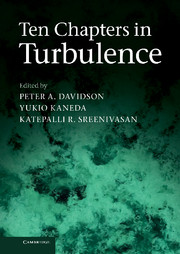Book contents
- Frontmatter
- Contents
- Preface
- Contributors
- 1 Small-Scale Statistics and Structure of Turbulence – in the Light of High Resolution Direct Numerical Simulation
- 2 Structure and Dynamics of Vorticity in Turbulence
- 3 Passive Scalar Transport in Turbulence: A Computational Perspective
- 4 A Lagrangian View of Turbulent Dispersion and Mixing
- 5 The Eddies and Scales of Wall Turbulence
- 6 Dynamics of Wall-Bounded Turbulence
- 7 Recent Progress in Stratified Turbulence
- 8 Rapidly-Rotating Turbulence: An Experimental Perspective
- 9 MHD Dynamos and Turbulence
- 10 How Similar is Quantum Turbulence to Classical Turbulence?
- References
7 - Recent Progress in Stratified Turbulence
Published online by Cambridge University Press: 05 February 2013
- Frontmatter
- Contents
- Preface
- Contributors
- 1 Small-Scale Statistics and Structure of Turbulence – in the Light of High Resolution Direct Numerical Simulation
- 2 Structure and Dynamics of Vorticity in Turbulence
- 3 Passive Scalar Transport in Turbulence: A Computational Perspective
- 4 A Lagrangian View of Turbulent Dispersion and Mixing
- 5 The Eddies and Scales of Wall Turbulence
- 6 Dynamics of Wall-Bounded Turbulence
- 7 Recent Progress in Stratified Turbulence
- 8 Rapidly-Rotating Turbulence: An Experimental Perspective
- 9 MHD Dynamos and Turbulence
- 10 How Similar is Quantum Turbulence to Classical Turbulence?
- References
Summary
Introduction
Stable density stratification can have a strong effect on fluid flows. For example, a stably-stratified fluid can support the propagation of internal waves. Also, at large enough horizontal scales, flow in a stably-stratified fluid will not have enough kinetic energy to overcome the potential energy needed to overturn; therefore flows at this horizontal scale and larger cannot overturn, greatly constraining the types of motions possible. Both of these effects were observed in laboratory experiments of wakes in stably-stratified fluids (see, e.g., (Lin and Pao, 1979)). In the wake experiments, generally the flow in the near wake of the source, e.g., a towed sphere or a towed grid, consisted of three-dimensional turbulence, little affected by the stable stratification. As the flow decayed, however, the effects of stratification became continually more important. After a few buoyancy periods, when the effects of stable stratification started to dominate, the flow had changed dramatically, and consisted of both internal waves and quasi-horizontal motions. Following Lilly (1983), we will call such motions, consisting of both internal waves and quasi-horizontal motions due to the domination of stable stratification, as “stratified turbulence”. It has become clear that such flows, while being strongly constrained by the stable stratification, have many of the features of turbulence, including being stochastic, strongly nonlinear, strongly dispersive, and strongly dissipative.
A primary interest in stratified turbulence is how energy in such flows, strongly affected by stable stratification, is still effectively cascaded down to smaller scales and into three-dimensional turbulence, where it is ultimately dissipated.
- Type
- Chapter
- Information
- Ten Chapters in Turbulence , pp. 269 - 317Publisher: Cambridge University PressPrint publication year: 2012
References
- 10
- Cited by



